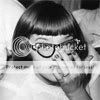- 08 Nov 2003 04:02
#42532
Quantum physics is probably the least understood field of physics that there is today. In this post I will discuss one of the simplest demostrations of quantum physics.
The experiment I will discuss was first conducted by Thomas Young. This experiment can actually be done at home, with very few materials needed, all of which you already have. What he did was take a single light source and shine it at a surface. In between that light source and the surface, he placed two partitions. The first partition has one slit in it, aligned straight with the light source. The second partition has two slits, each spaced an equal distance from where the slit is on the first partition. See the below figure:

Now when the light is turned on, you would expect to see the light to form a pattern such as this:

However, this is not what happens at all. The actual pattern of light looks exactly like this:

As you can see, the light hits the wall in five different spots, even though there are only two spots for the light to hit if it travels in a straight line through each slit in each partition. What's more interesting is that the position in the center of the surface is the brightest spot, and the outter two spots are indeed much dimmer, even though they are in the direct line-of-sight of the light source.
Looking straight on at the surface you would see a pattern similar to this:

Confused and amazed? It gets even better!
When the technology was available, this experiment was repeated, but this time, instead of using a source of light which emitted a constant stream of light, only one photon (particle which light is made of) was sent from the same place of origin, and using the same partitions. This is what happened:


This is one of the principles of The Heisenberg Uncertainty Principle. I don't want to get into the details of why the light behaves this way, as that's saved for another post I will be making soon.
Quantum Physics is based on uncertainty. The Heisenberg Uncertainty Principle says that the more you know about one property of an object, the less you know about the other properties. For example, the more you know about the speed of an atom in motion, the less you know about the position and direction of the object--since velocity is speed and direction. This probably seems confusing to everyone, but it's meant to be this way, as I said: quantum physics is probably the least understood fields of physics, but it is all very real.
If you have any questions, please feel free to ask. In the future, I will be discussing other experiments involving quantum physics, and they all equally defy the conventional understanding of physics.
The experiment I will discuss was first conducted by Thomas Young. This experiment can actually be done at home, with very few materials needed, all of which you already have. What he did was take a single light source and shine it at a surface. In between that light source and the surface, he placed two partitions. The first partition has one slit in it, aligned straight with the light source. The second partition has two slits, each spaced an equal distance from where the slit is on the first partition. See the below figure:

Now when the light is turned on, you would expect to see the light to form a pattern such as this:

However, this is not what happens at all. The actual pattern of light looks exactly like this:

As you can see, the light hits the wall in five different spots, even though there are only two spots for the light to hit if it travels in a straight line through each slit in each partition. What's more interesting is that the position in the center of the surface is the brightest spot, and the outter two spots are indeed much dimmer, even though they are in the direct line-of-sight of the light source.
Looking straight on at the surface you would see a pattern similar to this:

Confused and amazed? It gets even better!
When the technology was available, this experiment was repeated, but this time, instead of using a source of light which emitted a constant stream of light, only one photon (particle which light is made of) was sent from the same place of origin, and using the same partitions. This is what happened:


This is one of the principles of The Heisenberg Uncertainty Principle. I don't want to get into the details of why the light behaves this way, as that's saved for another post I will be making soon.
Quantum Physics is based on uncertainty. The Heisenberg Uncertainty Principle says that the more you know about one property of an object, the less you know about the other properties. For example, the more you know about the speed of an atom in motion, the less you know about the position and direction of the object--since velocity is speed and direction. This probably seems confusing to everyone, but it's meant to be this way, as I said: quantum physics is probably the least understood fields of physics, but it is all very real.
If you have any questions, please feel free to ask. In the future, I will be discussing other experiments involving quantum physics, and they all equally defy the conventional understanding of physics.












 - By Rancid
- By Rancid - By Doug64
- By Doug64